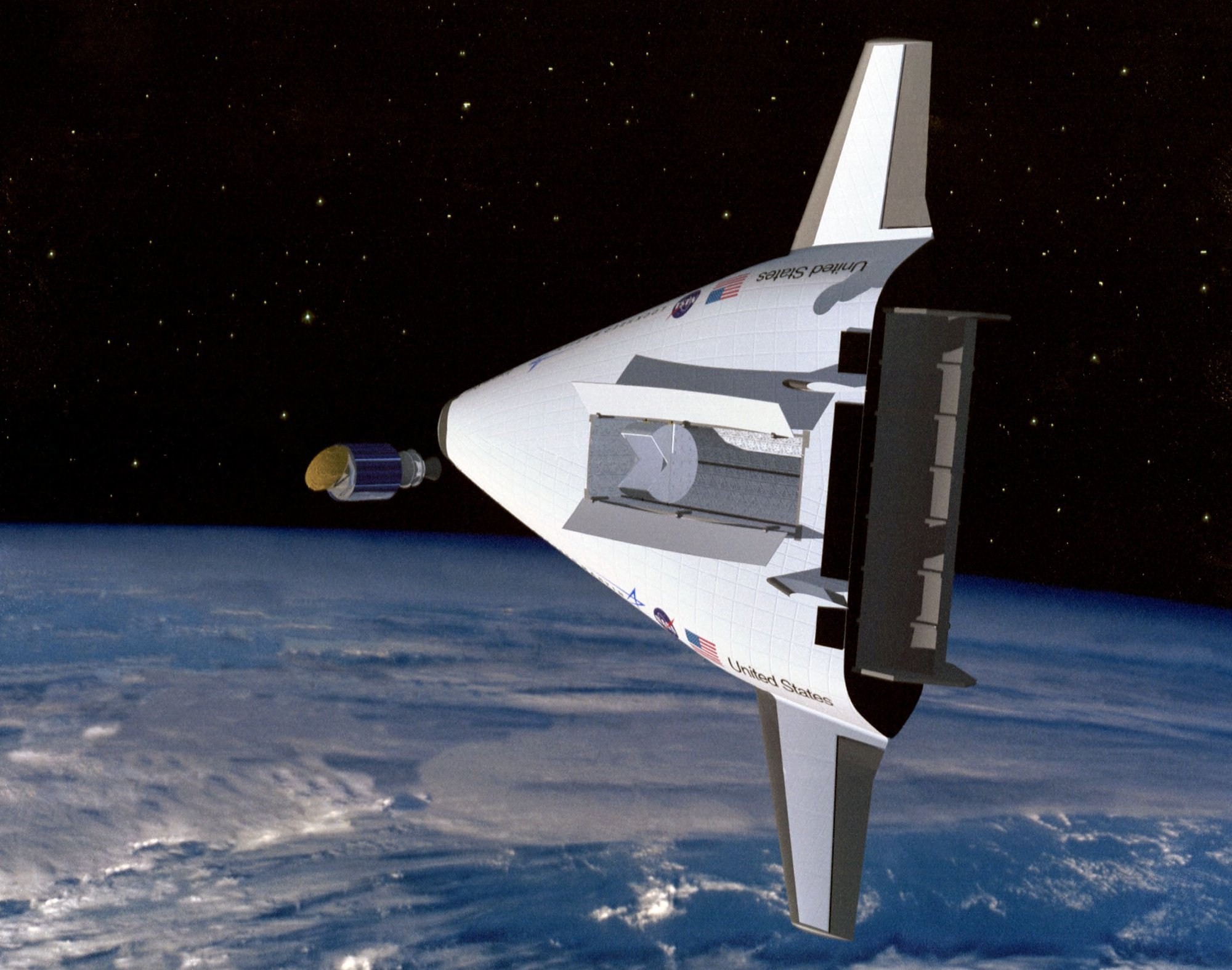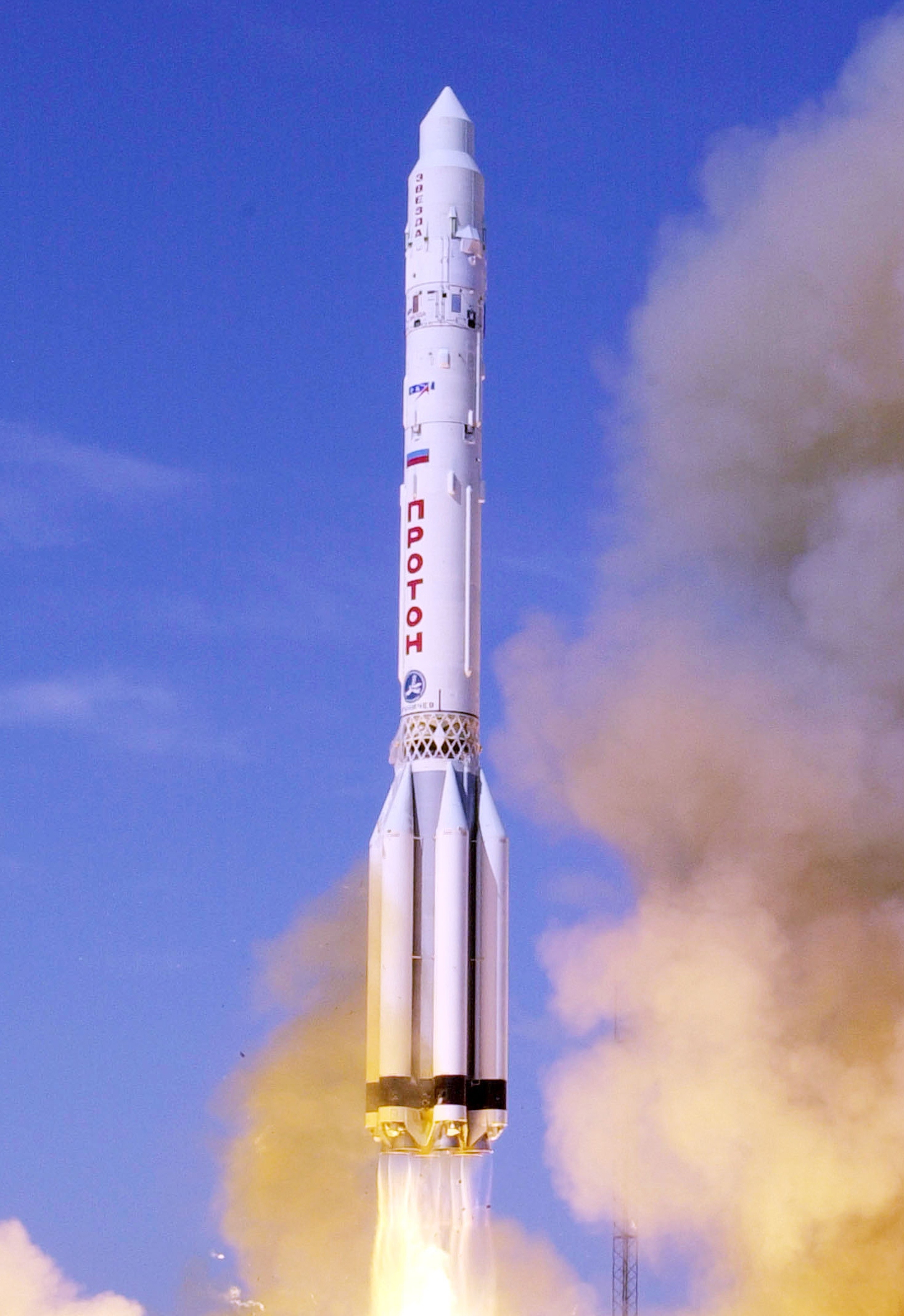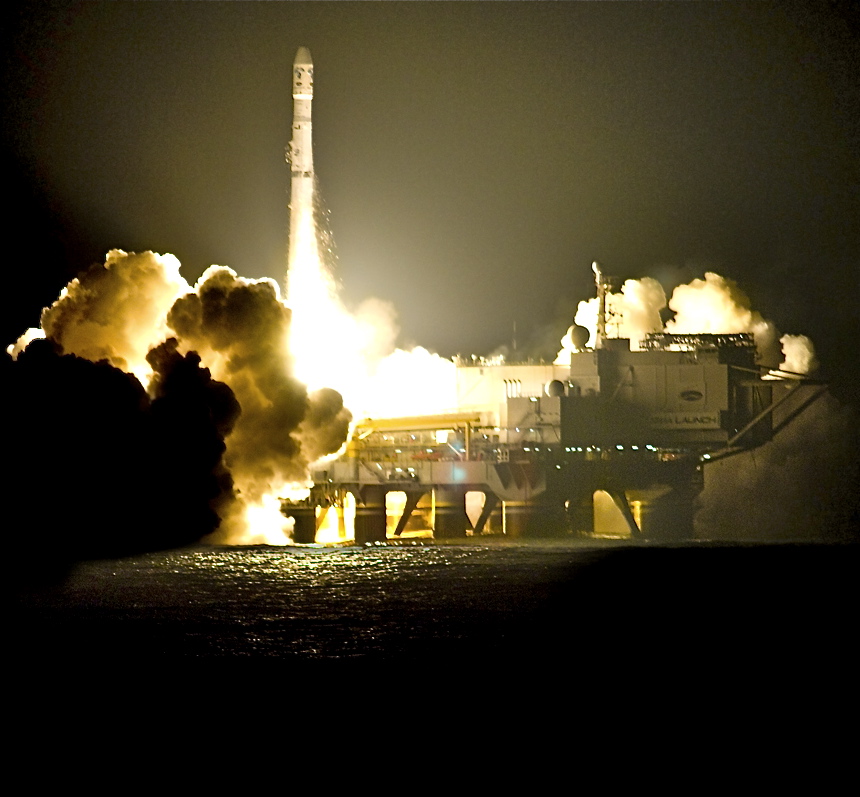|
Aquarius (rocket)
Aquarius is a launch vehicle concept designed for low-cost by Space Systems/Loral to carry small, inexpensive payloads into LEO. Concept The vehicle was primarily intended for launching bulk products, like water, fuel, and other consumables, that are inexpensive to replace in the event of a launch failure. The target launch cost was $1 million. Aquarius was designed to be a single-stage vehicle 43 meters (141 ft) high and 4 meters (13.1 ft) in diameter and powered by a single pressure fed engine using liquid hydrogen and oxygen propellants stored in a composite pressure tank. Launch would have taken place from a floating position in the ocean to minimize launch infrastructure with the ability to place a 1,000-kilogram (2,200 lb) payload into a , 52-degree orbit. The payload, located in the base of the vehicle, would be extracted by an orbiting space tug for transfer to its ultimate destination, like the ISS or a propellant depot, after which the vehicle would de-orb ... [...More Info...] [...Related Items...] OR: [Wikipedia] [Google] [Baidu] |
SSTO
A single-stage-to-orbit (SSTO) vehicle reaches orbit from the surface of a body using only propellants and fluids and without expending tanks, engines, or other major hardware. The term usually, but not exclusively, refers to reusable vehicles. To date, no Earth-launched SSTO launch vehicles have ever been flown; orbital launches from Earth have been performed by either fully or partially expendable multi-stage rockets. The main projected advantage of the SSTO concept is elimination of the hardware replacement inherent in expendable launch systems. However, the non-recurring costs associated with design, development, research and engineering (DDR&E) of reusable SSTO systems are much higher than expendable systems due to the substantial technical challenges of SSTO, assuming that those technical issues can in fact be solved. SSTO vehicles may also require a significantly higher degree of regular maintenance. It is considered to be marginally possible to launch a single-stage- ... [...More Info...] [...Related Items...] OR: [Wikipedia] [Google] [Baidu] |
Air Force Research Laboratory
The Air Force Research Laboratory (AFRL) is a scientific research organization operated by the United States Air Force Materiel Command dedicated to leading the discovery, development, and integration of aerospace warfighting technologies, planning and executing the Air Force science and technology program, and providing warfighting capabilities to United States air, space, and cyberspace forces. It controls the entire Air Force science and technology research budget which was $2.4 billion in 2006. The Laboratory was formed at Wright-Patterson Air Force Base near Dayton, Ohio, on 31 October 1997 as a consolidation of four Air Force laboratory facilities (Wright, Phillips, Rome, and Armstrong) and the Air Force Office of Scientific Research under a unified command. The Laboratory is composed of eight technical directorates, one wing, and the Office of Scientific Research. Each technical directorate emphasizes a particular area of research within the AFRL mission which it s ... [...More Info...] [...Related Items...] OR: [Wikipedia] [Google] [Baidu] |
Cancelled Space Launch Vehicles
Cancel or cancellation may refer to: *Flight cancellation and delay, not operating a scheduled flight Sociology * Cancel culture, boycott and ostracism calling out offensive behavior on social media or in real life Technology and science *Cancel leaf, a bibliographic term for replaced leaves in printed books *Cancellation property, the mathematical property if ''a''×''b'' = ''a''×''c'' then ''b'' = ''c'' **Cancelling out, a technique for simplifying mathematical expressions *Catastrophic cancellation, numerical error arising from subtracting approximations to nearby numbers *Noise cancellation, a method for reducing unwanted sound *Interference (wave propagation), Phase cancellation, the effect of two waves that are out of phase with each other being summed *Cancel message, a special message used to remove Usenet articles posted to news servers *Cancel character, an indication that transmitted data are in error or are to be disregarded *Resolution_(logic)#Resolution_rul ... [...More Info...] [...Related Items...] OR: [Wikipedia] [Google] [Baidu] |
Space Access
Space is the boundless three-dimensional extent in which objects and events have relative position and direction. In classical physics, physical space is often conceived in three linear dimensions, although modern physicists usually consider it, with time, to be part of a boundless four-dimensional continuum known as spacetime. The concept of space is considered to be of fundamental importance to an understanding of the physical universe. However, disagreement continues between philosophers over whether it is itself an entity, a relationship between entities, or part of a conceptual framework. Debates concerning the nature, essence and the mode of existence of space date back to antiquity; namely, to treatises like the ''Timaeus'' of Plato, or Socrates in his reflections on what the Greeks called ''khôra'' (i.e. "space"), or in the ''Physics'' of Aristotle (Book IV, Delta) in the definition of ''topos'' (i.e. place), or in the later "geometrical conception of place" as "space ... [...More Info...] [...Related Items...] OR: [Wikipedia] [Google] [Baidu] |
Single-stage-to-orbit
A single-stage-to-orbit (SSTO) vehicle reaches orbit from the surface of a body using only propellants and fluids and without expending tanks, engines, or other major hardware. The term usually, but not exclusively, refers to reusable vehicles. To date, no Earth-launched SSTO launch vehicles have ever been flown; orbital launches from Earth have been performed by either fully or partially expendable multi-stage rockets. The main projected advantage of the SSTO concept is elimination of the hardware replacement inherent in expendable launch systems. However, the non-recurring costs associated with design, development, research and engineering (DDR&E) of reusable SSTO systems are much higher than expendable systems due to the substantial technical challenges of SSTO, assuming that those technical issues can in fact be solved. SSTO vehicles may also require a significantly higher degree of regular maintenance. It is considered to be marginally possible to launch a single-stage- ... [...More Info...] [...Related Items...] OR: [Wikipedia] [Google] [Baidu] |
Private Spaceflight
Private spaceflight is spaceflight or the development of spaceflight technology that is conducted and paid for by an entity other than a government agency. In the early decades of the Space Age, the government space agencies of the Soviet Union and United States pioneered space technology in collaboration with affiliated design bureaus in the USSR and private companies in the US, entirely funding both the development of new spaceflight technologies and the operational costs of spaceflight. The European Space Agency was formed in 1975, largely following the same model of space technology development. However, Arianespace became the world's first commercial launch service provider in the early 1980s. Later on, large defense contractors began to develop and operate space launch systems, derived from government rockets. Private spaceflight in Earth orbit includes communications satellites, satellite television, satellite radio, astronaut transport and sub-orbital and orbital spa ... [...More Info...] [...Related Items...] OR: [Wikipedia] [Google] [Baidu] |
Sea Launch
Sea Launch was a multinational—Norway, Russia, Ukraine, United States—spacecraft launch company founded in 1995 that provided orbital launch services from 1999–2014. The company used a mobile maritime launch platform for equatorial launches of commercial payloads on specialized Zenit-3SL rockets from a former mobile/floating oil drilling rig renamed ''Odyssey''. By 2014, it had assembled and launched thirty-two rockets, with an additional three failures and one partial failure. All commercial payloads were communications satellites intended for geostationary transfer orbit with such customers as EchoStar, DirecTV, XM Satellite Radio, PanAmSat, and Thuraya. The approach Sea Launch LLC used was to assemble the launcher on a purpose-built ship ''Sea Launch Commander'' in Nimitz Rd., Long Beach, California, USA. The assembled spacecraft was then positioned on top of the self-propelled ''Odyssey'' floating launch platform and moved to the equatorial Pacific Ocean for launc ... [...More Info...] [...Related Items...] OR: [Wikipedia] [Google] [Baidu] |
Sea Dragon (rocket)
The Sea Dragon was a 1962 conceptualized design study for a two-stage sea-launched orbital super heavy-lift launch vehicle. The project was led by Robert Truax while working at Aerojet, one of a number of designs he created that were to be launched by floating the rocket in the ocean. Although there was some interest at both NASA and Todd Shipyards, the project was not implemented. With dimensions of long and in diameter, Sea Dragon would have been the largest rocket ever built. , among rockets that have been fully conceived but not built, it is by far the largest ever and, in terms of payload into low Earth orbit (LEO), equaled only by the Interplanetary Transport System concept (the predecessor to SpaceX Starship) in the latter's expendable configuration with both designed for 550 tonnes. Design Truax's basic idea was to produce a low-cost heavy launcher, a concept now called "big dumb booster." To lower the cost of operation, the rocket itself was launched from the ocean, r ... [...More Info...] [...Related Items...] OR: [Wikipedia] [Google] [Baidu] |
Pressure-fed Engine
The pressure-fed engine is a class of rocket engine designs. A separate gas supply, usually helium, pressurizes the propellant tanks to force fuel and oxidizer to the combustion chamber. To maintain adequate flow, the tank pressures must exceed the combustion chamber pressure. Pressure fed engines have simple plumbing and have no need for complex and occasionally unreliable turbopumps. A typical startup procedure begins with opening a valve, often a one-shot pyrotechnic device, to allow the pressurizing gas to flow through check valves into the propellant tanks. Then the propellant valves in the engine itself are opened. If the fuel and oxidizer are hypergolic, they burn on contact; non-hypergolic fuels require an igniter. Multiple burns can be conducted by merely opening and closing the propellant valves as needed, if the pressurization system also has activating valves. They can be operated electrically, or by gas pressure controlled by smaller electrically operated valves. Care ... [...More Info...] [...Related Items...] OR: [Wikipedia] [Google] [Baidu] |
Commercial Orbital Transportation Services
Commercial Orbital Transportation Services (COTS) was a NASA program to coordinate the development of vehicles for the delivery of crew and cargo to the International Space Station by private companies. The program was announced on January 18, 2006 and successfully flew all cargo demonstration flights by September 2013, when the program ended. NASA's Final Report on the Commercial Orbital Transportation Services program considers it an unqualified success and a model for future public-private collaboration. Compared to traditional cost-plus contracts employed by NASA, such as the $12 billion Orion (spacecraft) contract, the unprecedented efficiency of the $800 million COTS investment resulted in "two new U.S. medium-class launch vehicles and two automated cargo spacecraft". NASA signed COTS agreements with SpaceX and Rocketplane Kistler (RpK) in 2006, but later terminated the agreement with RpK due to insufficient private funding. NASA then signed an agreement with Orbital Scie ... [...More Info...] [...Related Items...] OR: [Wikipedia] [Google] [Baidu] |
Constellation Services International
A constellation is an area on the celestial sphere in which a group of visible stars forms a perceived pattern or outline, typically representing an animal, mythological subject, or inanimate object. The origins of the earliest constellations likely go back to prehistory. People used them to relate stories of their beliefs, experiences, creation, or mythology. Different cultures and countries adopted their own constellations, some of which lasted into the early 20th century before today's constellations were internationally recognized. The recognition of constellations has changed significantly over time. Many changed in size or shape. Some became popular, only to drop into obscurity. Some were limited to a single culture or nation. The 48 traditional Western constellations are Greek. They are given in Aratus' work ''Phenomena'' and Ptolemy's '' Almagest'', though their origin probably predates these works by several centuries. Constellations in the far southern sky were ad ... [...More Info...] [...Related Items...] OR: [Wikipedia] [Google] [Baidu] |







